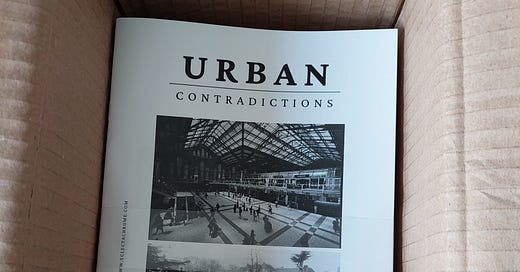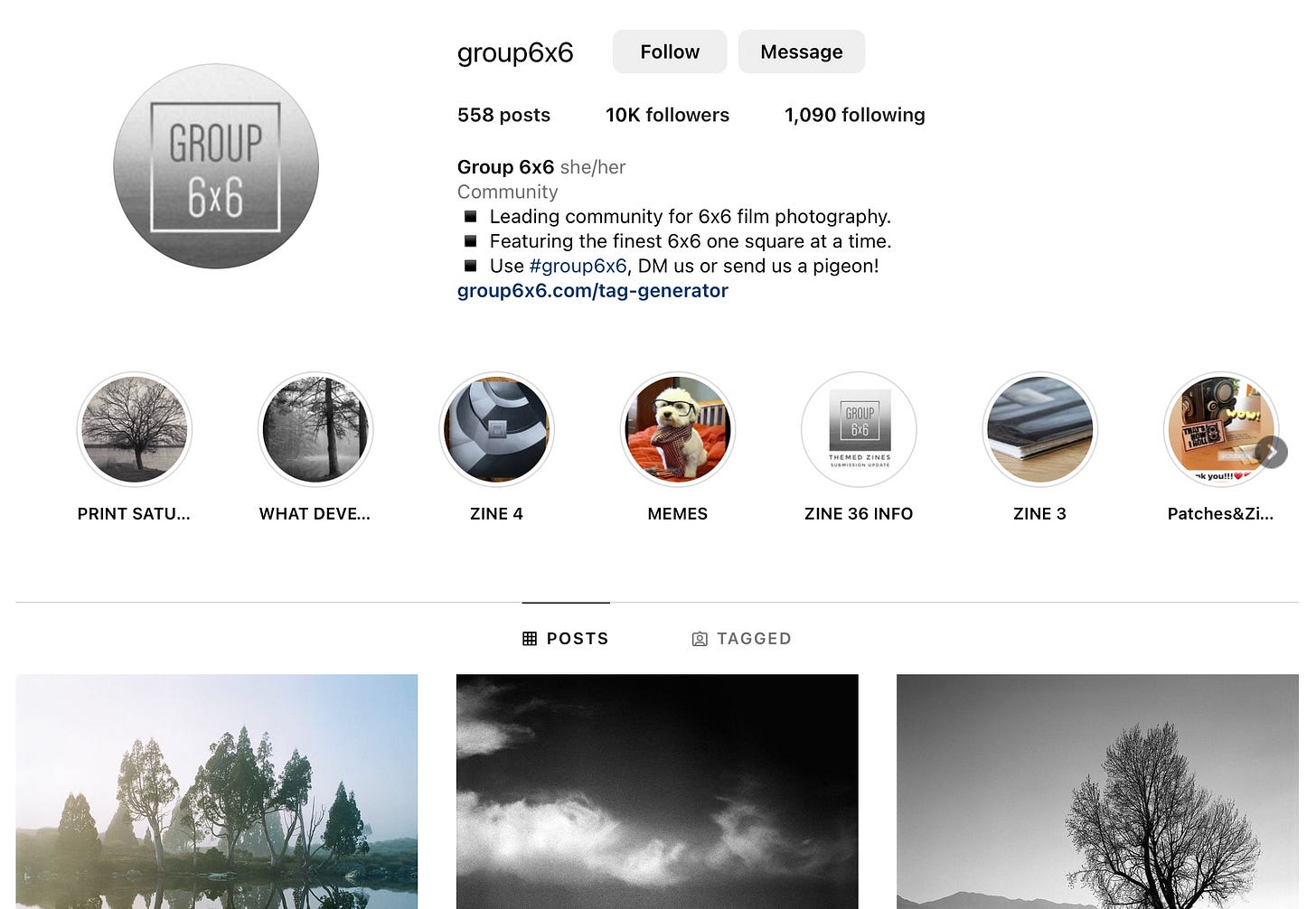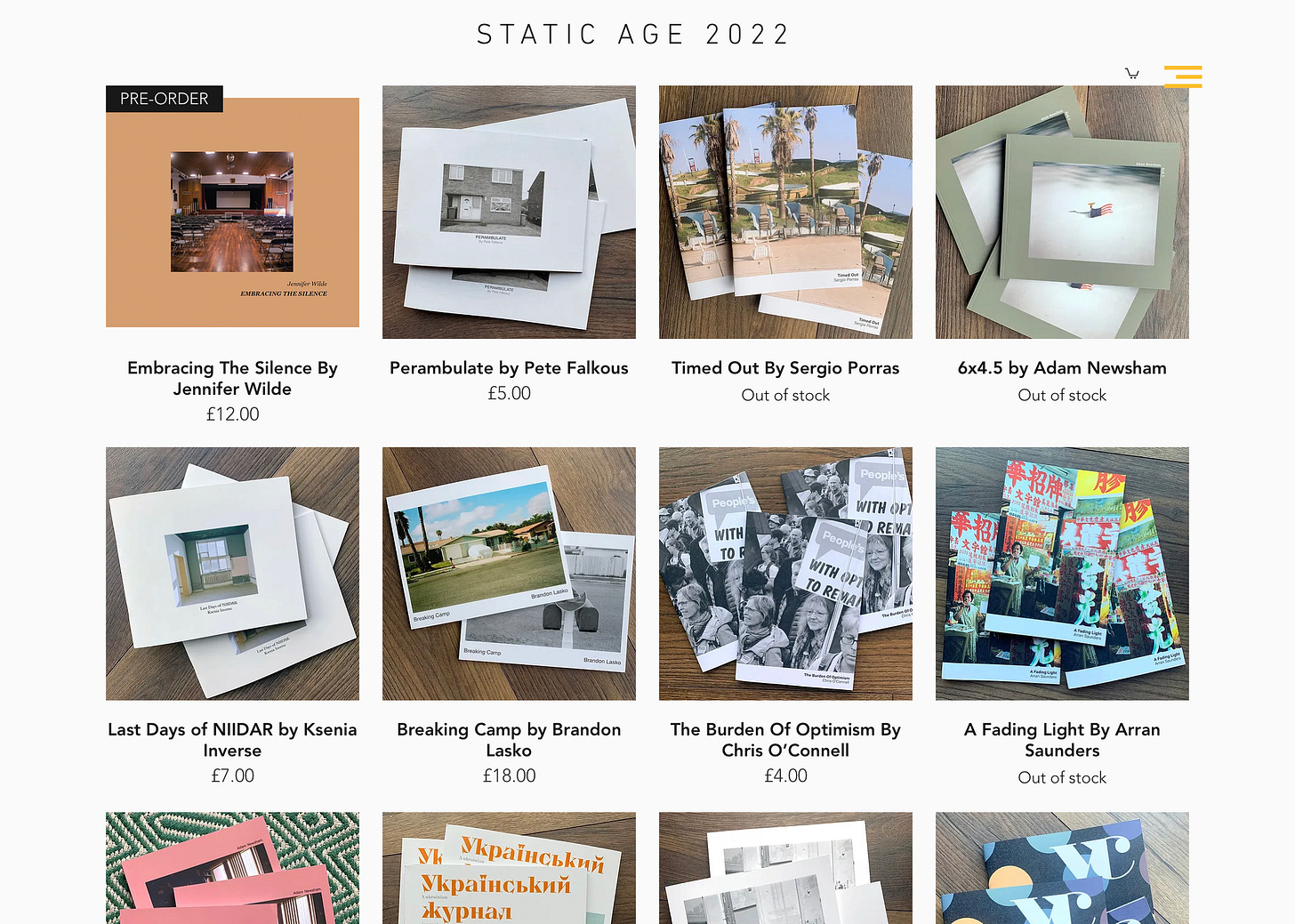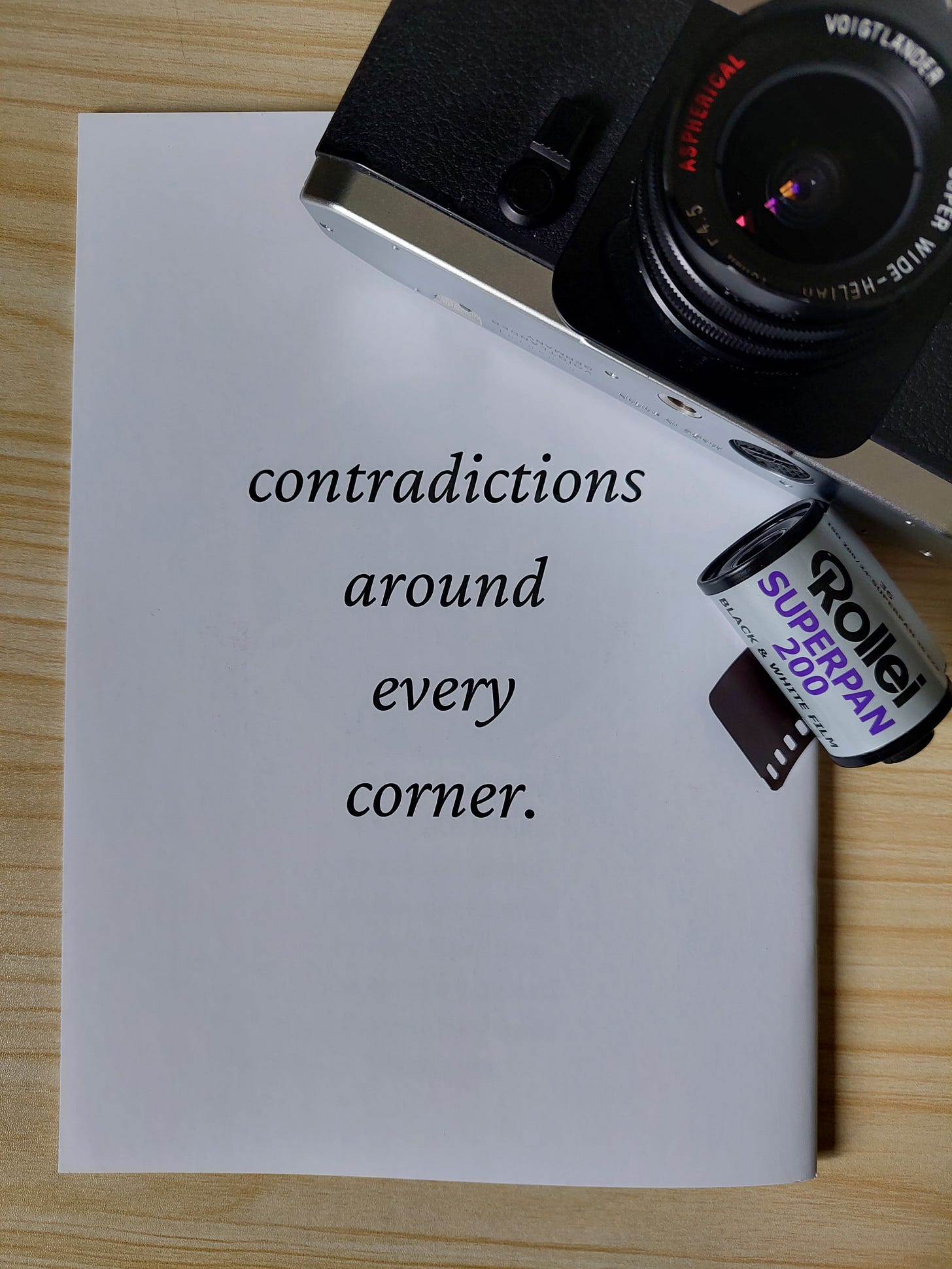Why Zines Are Better Than Photobooks & Other Outrageous Statements
Taking your work off-screen and into the real world
This subscriber newsletter is going to be all about zines!
I have also recorded a voiceover for this if you prefer to listen.
Before I get into the meaty bits though, I need to fangirl for a hot second about zines in general…
WHY ZINES ARE AMAZING
For a moment, let’s mention the different ways you can support artists or bring the beauty of created art into your home, sticking to tangible 3D mediums.
Photobooks
The past two years, I’ve heard more about photographers investing in photobooks than ever before.
“Invest in books, not gear”
Buy books from the masters and be inspired by the best.
Good stuff right?
Well, yes, but allow me a few counterpoints on this.
Photobooks are expensive and many people don’t have the budget to “invest” in them.
Photobooks are heavy and can take up a lot of space. For those that don’t have large bookshelves or might move around frequently, this is not so ideal. Also, if they are not specifically “lay-flat” books, it can be hard to view the page fully for fear of cracking the binding. I usually end up cracking the binding…
Photobooks are often created by or for or about the “Masters” (noting this is often used as a male-gendered term which has been used so often now, it makes me cringe a little inside), which can create the perception that THIS is how photography should be done. If it’s in a book, it’s excellence and anything not, might be more amateur and not worth being inspired by, no? (the answer is no btw from where I’m standing) ;p
Photobooks are heralded. Podiumed. I’m not above making up words to support a point!
They are great, but perhaps not so great for everyone. Perhaps there is something better…
Side note: you can find photobooks at your local library often, but the selection may be limited or dated. However, it’s still a free option to check out!
Prints
Prints are a great way to support artists and also beautify your space. Anyone can sell prints these days with the help of platforms like Darkroom.tech.
I’ve set up a print store there and it’s very easy to get running with your own. Easy to share the link and have folks purchase from your shop. (pssssst…my link is here)
Ok, Fabulous!
Now for the downsides:
There is only so much wall-space.
If you are into interior design, you may be shopping for an aesthetic that matches your theme or colors rather than selecting a favorite print from a favorite artists
Frames can be expensive. However, if you shop for budget frames or even used frames at thrifty shops, this isn’t such a huge expense so this is really a lukewarm downside.
Zines
The holy grail of printed works for the budget and space minded people like myself.
Easy to make, easy to read, easy to store, and most of the time, very affordable.
For £5-15, you can own a work of art from a fellow creative and don’t have to worry if it will match the wall paint you spent hours rolling on.
With shipping costs rising, buying or selling a photobook seems unimaginable. Especially if you want to ship out of the country.
Well, the cat is out of the bag. I prefer zines.
All that being said, let’s talk about some!
I want to share a few of my favourites in my small collection.
Then I will get on with it and share how I made my own!
By the way, if you have any zines to recommend, please shout them out in the comments below.
A SMALL ZINE COLLECTION
Ok, so starting off with zines on my bookshelf.
Jason Valenzuela
I met Jason through social media. He was one of the first to inspire me to create my own zine and sent me a couple of his as examples! Which was very generous.
One called Daydreaming and one called Structural examples.
Check out Jason’s Instagram at JTV_805 (@j.t.v._photography) • Instagram photos and videos
Or on his website at Jason Valenzuela (lofilokeyphotography.xyz)
Emulsive Secret Santa - Nigel Fishwick
Emulsive holds a Elfster secret santa every year. I took part for the first time in 2021 and now am hooked. My 2021 secret santa, aside from sending me a bunch of film, also sent me his zines which I found very interesting.
The zines revealed my secret santa as Nigel Fishwick! Check out Nigel’s work further on Steel City Snapper here The Steel City Snapper 📸 (@steelcitysnapper) • Instagram photos and videos
Group 6x6
Analogue Holly, a fabulous Youtube channel led by Holly with appearances by Digital Eve as well, did a zine pick ups video and she shared Group 6x6, which I had not heard of before. It is a group that publishes zines only in 6x6 format taken with 6x6 cameras.
The zine is super small and cute and good quality. The photos are amazing and I definitely recommend checking them out.
They also have an Instagram account and you can share your 6x6 photos with them using their hastag.
Group 6x6 (@group6x6) • Instagram photos and videos
Brown Owl Press
This is an independent publisher of photo books and zines based in Newcastle, UK.
One of the zines I bought from them is by Karen Kirchhoff called IN THE BASEMENT, Punk Music Spaces. Which is what it sounds like, photographs of where punk music was celebrated but not at night and empty of people.
Karen Kirchhoff (@art_karen_kirchhoff) • Instagram photos and videos
The other is a poetic book by Grace Ann Leadbeater called Even the Sound of Your Name. Grace is an Artist/educator invested in words, pictures, and bookmaking in Brooklyn, NY. The zine is a soft but emotional note to something special and Grace’s writing is lovely to read.
Grace’s website is About Page - Grace Ann Leadbeater
Instagram Grace Ann Leadbeater (@graceannleadbeater) • Instagram photos and videos
Cafe Royal Books
Café Royal Books is a publishing house based in Southport, UK, founded in 2005 by Craig Atkinson.
They release weekly publications, focussing on post-war documentary photography linked to Britain and Ireland. This includes the work of photographers from all backgrounds, the widely known, the unseen and the underrepresented.
Cafe Royal Books are all photographs and no words (from the ones I got).
I bought Punks 1980s by Shirley Baker and Ireland 1972-73 by Marketa Luskacova.
Shirley Baker (1932 – 2014) was one of Britain’s most compelling yet underexposed social documentary photographers. Her street photography of the working-class inner-city areas, taken from 1960 until 1981, would come to define her humanist vision. She took up photography at the age of eight when she and her twin sister were given Brownie cameras by an uncle.
Throughout the 1960s and 1970s she often submitted her work to the Manchester Guardian, Amateur Photographer, Cheshire Life, The Lady and various travel magazines. Her inner-city street scenes were used by various council departments for public information exhibitions.
In the 1980s, when Shirley’s doctor husband’s work took them to London for a time, she photographed punks in and around Camden and the West End.
Source: About - Shirley Baker photographer (shirleybakerphotography.com)
Ireland 1972-73 was photographed by Marketa Luskacova.
Marketa earned a degree in sociology of culture at Charles University (Prague) in 1967.
In 1968, she became a freelance photographer and spent time covering the pilgrims in Slovakia. She had several projects in Slovakia and Prague, but also covered Ireland in 1972, 1973, and 1985.
Source: Marketa Luskacova
I initially picked these two up because I was looking for zines that were published on or by photographers that were women, after looking through a few other publishers and noticing that only one or two out of dozens of their books were written or photographed by women.
So I went on a hunt, determined that they existed, just not in the mainstream or places I was looking.
Cafe Royal Books has quite a few which is great.
Café Royal Books (caferoyalbooks.com)
Static Age Zines
Static Age Zines is also based in Newcastle, UK.
Here, I found Angel by Evelyne Dierikx.
This is her project photographing Angel statues from all over the world using different cameras and techniques. The result is a mysterious and dreamy set of images.
Home | analogphotography (evelynedierikx.wixsite.com)
Evelyne Dierikx (@evelynedierikx) • Instagram photos and videos
Matt Loves Cameras
In addition to the beautiful community zines he has created, Matt Murray also made personal zines.
I bought Matt’s “Every Summer” zine, which is based on his holiday on the Isle of Wight.
The image below is a screenshot from Matt’s website from the Every Summer Page. Check it out here.
It is so charming and I definitely recommend it. I really enjoy all of the writing in it as you get to know the photographer more and the process behind the images.
This is one of the best things about zines is the photographer’s writing and I miss that in zines with no writing. It doesn’t have to be much, but a little something or even a little poetry adds so much.
ECLECTACHROME ZINES
Ok, so now for my own zine and how I made it.
The first step in creating anything is having the idea or the inspiration.
Since arriving in the UK in November 2019, I have been without a car. This means I am limited to spaces on public transport pathways or foot pathways. I love both the city and country so would often look for an oasis of peace, quiet, and nature in the middle of city life.
I found often that “around the corner” from busy intersections would be a backstreet leading to a tiny park, or a huge park just behind this tube station that is incredibly peaceful while at the same time, chaos ensues within the station.
So this is what I explored in this zine, city living and the juxtaposition of chaos and quiet.
“Urban Contradictions”
Selecting Photos and Sequencing
With “Urban Contradictions” in mind, I went through my archive from my time mostly in London and created a folder of about 150-200 images that fell under this concept.
It helped that I already had the images for the project and didn’t need to go out and take anymore. All projects are different though and sometimes the idea comes before the images or vice versa.
My next step was to order 4x6 prints of the photos I selected. I think I did this at photobox or something similar. I usually look at different photo print shops online and determine which is the best deal based on sales or discounts that might be running at the time.
When the prints arrived, I took a weekend morning to lay them out on my bedroom floor and match them up to each other.
I paired them up best I could with busy and quiet from the same corner and then eliminated the weaker pairs of images until I had a smaller amount of pairs for the book.
Then I laid these pairs out in the order I thought they should go which ended up getting rearranged a few times. I even asked Mike to come over and had a look and asked his opinion and he helped me eliminate some pairs or rearrange a few.
Always great to have an outsiders view especially if you have been looking at it for a long time and your brain might be a bit fried.
There is a greater science behind sequencing and some photographers offer courses on this subject alone. I went off intuition and feeling rather than a specific science.
If sequencing is something that is tying you up, don’t think too much about it and place things in an order that visually is pleasing to you. Your eye has been trained from learning photography and compositional rules (and even breaking those rules) so don’t be afraid to lay things out how you like it. Chances are, most others will like it as well.
Getting the Zine in Form!
So with the final order ready on my bedroom floor, I took the same images that were saved on my computer and uploaded them into Canva.
Canva is a great platform for this purpose!
I selected a plain magazine format and placed each pair in order on individual pages, keeping it simple.
My design choice was minimalistic as this best suits me. Maximalism is not my strong point.
Within the Canva software, it’s very easy to line things up and make sure the images and texts are in their proper place.
Finding a Printer
I had been researching places to print and came across Mixam UK which seemed to have the simplest ordering system. Great for me because complicated ordering processes totally put me off!
So I ordered Mixam’s sample paper pack to get a feel in 3D of what the paper would be like as you couldn’t really order a sample zine from them, you had to order at least 20 or so copies.
I picked the papers that felt good to me. This is completely personal preference and budget.
The next step was to get the design of the zine finalized into a PDF to upload to Mixam.
From Canva, I was able to download a PDF of my design to the dimensions that Mixam instructed me to, and easily upload into the Mixam ordering screen.
Within the same Mixam ordering screen, there are options to select what kind of paper you want, what size the zine is to be, and if your design includes a cover page or not.
Once everything was as I wanted it to be, I hit submit!
And that was it!
I received the zines not too long after and was pleased with the printing quality for most of them.
There were a few copies that had odd purple tint to the bw images, but that’s why I think Mixam threw a few extra copies into the box.
So that’s basically how I made the zine, it was a very simple process. I’m sure you can find better printers out there, but I liked how simple Mixam was, and how easy it was to design with Canva.
Let me know if you have made your own zine and how you did it.
That’s all for now, see you in the next one!
Take care,
-M













Wow! So much good information here - thank you for taking the time to put this all together. I definitely see myself reading (or listening!) to this many times